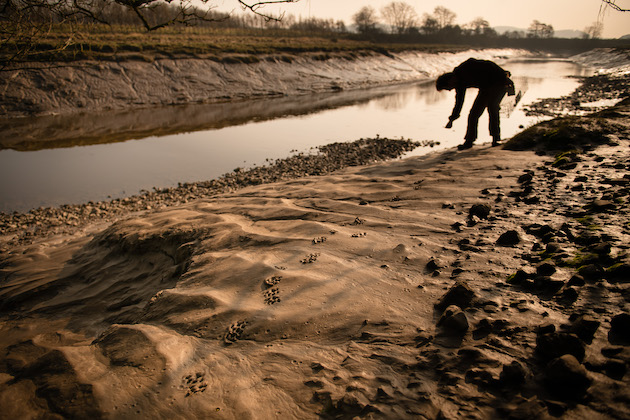All about the mink and why mink rafts are an effective form of control
Most people agree that mink need to be controlled and mink rafts as recognised as the most effective way. Writing in Shooting Times, Mike Swan shows how to use them.

Mink footprints
With all the news about new rules for trapping stoats, and changes to general licences for corvid control, it’s easy to forget that there are other predators out there that we need to address – like the American mink
Why we need to control mink
When we think about mink control, we tend to think about water vole conservation, but there are lots of other reasons. Most predators will ‘surplus kill’ given abundant prey, but mink are particularly strong on this, hence the mayhem if one gets among your newly released poults in their pen. Similarly, one visit to a nesting gull or tern colony on a little island is all that it takes to destroy the lot. They will also kill nesting ducks and waders, spawning trout and other fish
IN the 1960s work led to a much better understanding of how mink operate, developing the conventional trapping techniques that are still widely used today.
Twenty or so years ago the GWCT predation research team decided to try to get a better handle on mink. Having recently hit on a great way to catch crows and magpies, by using Larsen traps and keying into their territorial instinct, it asked the question: “What really matters to mink?” Could rafts be an answer?

American mink (Mustela vison).
Mink rafts
Rafts had been used on the tidal waters of East Anglia as a key part of the successful coypu eradication programme, so it seemed worth a try, especially as the coypu traps often caught mink. They were not coming for the carrots used as bait, so perhaps there was something about rafts? It was also the case that floating flotsam piles had already proved to be good sites for a cage.
We asked a summer student, Rhian Leigh to see if she could detect mink presence using rafts with a tunnel and a clay tracking pan. Working in the upper Avon catchment, where 20% of the local riverkeepers thought that they had mink, our GWCT team did a thorough survey and found mink signs at 30% of the chosen raft sites. The rafts then detected mink at 55% of sites, showing a huge potential to help with mink control. Having been impressed by our early results, the Environment Agency found a small pot of money that needed using up before the year end, that enabled us to take the project to the next stage.

Mike putting the raft into position
Using what was christened the GWCT mink raft on the River Itchen between Winchester and Southampton, our team was able to remove the mink on 10km of river and associated carriers within a few weeks, keeping it that way for the full summer season. Further experiments on other catchments showed the same things; rafts are far more effective at detecting mink presence than other methods, and they are also superb trapping sites. If you find footprints on the clay pan, slip in a cage trap, screw it down and you can expect to catch the mink within a few days, unless it has moved on or you have already caught it elsewhere.
Just like the Larsen trap, the GWCT mink raft is highly reliable and target specific.

Inserting the clay tracking pan into the mink raft
Cage checks
Once a cage is set, you need to check it every day. Failure to do so risks leaving a live mink in a cage indefinitely and would be a breach of the Animal Welfare Act. This is one of the two key problems with conventional trapping. You need to check cages every day, even when there are no mink to catch. The other is that when there are no mink, you can only catch non-targets. With just its clay tracking pan in place, you can check your raft whenever it is convenient and only set a trap when there is something to catch. Rafts will work on pretty much any sort of water: rivers, streams, drains, ditches, ponds and lakes. They do not need to be out in the middle, and there is no need to disguise it, other than from meddling people. If your stream is prone to spates, anchor it in a backwater, where it will likely get flipped onto the bank and out of the way when the waters rise. One raft per kilometre of watercourse seems to be a good rate of distribution and you can download the free fact sheet on how to manage mink rafts from the GWCT website.

The GWCT recommends the use of a powerful air pistol for the humane despatch of mink
Humane despatch
Early in our project, the GWCT team developed the use of a powerful air pistol as an unobtrusive way of dealing with a cage-trapped mink. If you choose this method, please follow the advice in the fact sheet to the letter. Using a .177 airgun rather than a .22 may seem counter-intuitive, but the small steel pellet is in effect a sharp instrument that penetrates the skull much further. For most of us the much easier method is to use a shotgun from 10 or a dozen paces, and I can vouch for the fact that No 4 steel shot neither destroys the trap, nor ricochets more than lead. That said, safety glasses are an obvious precaution, as well as hearing protection.
Mink control is one of those many areas where shoot management and mainstream conservation go hand in hand, and all shoots that have water should be running a raft or two. The cost and effort are small but the rewards are real.








